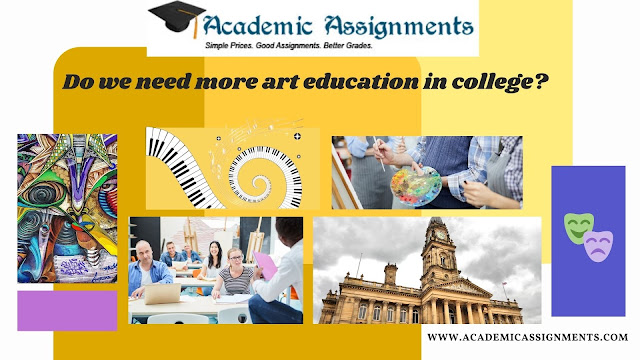Do we need more art education in college?
- Get link
- X
- Other Apps
Art_
“Art is a line around
your thoughts” - Gustav Klimt, thoughtfully wrote how art reflects our
perspective towards humanity. The term art although evolved in several ways,
encompasses painting your visions in the form of sculpture, decorative art, and
drawings.
A certain
painting delivers different objectives to humans, meaning one draws from it. It
allows us to narrate stories, record history and so on.
Relevance of art
Art resembles culture
Art is a barometer that quantifies based on cultural sophistication. Art makes life simpler to manage, acceptable, and pleasurable. The National Gallery Museum, for example, has shaped its cultural art on an international scale.
Art conveys
messages
Anybody can create something which carries a message, whether it is political, social, cultural, historical, religious, or devoid of any message or intent.
Art as a therapeutic
tool
Many people use art as
a therapeutic tool, and it is an important vehicle for maintaining emotional
and mental well-being. According to research, greater participation in the arts
is associated with a higher level of subjective well-being.
Furthermore, participation in the arts has been shown to improve cognitive function in people of all ages and to aid in the treatment of a variety of illnesses such as dementia, and depression.
Builds self-awareness
Art heightens
self-awareness and allows us to be open and receptive to new ideas and
perspectives. Paintings show how art evolved and became more sophisticated as
history progressed.
Why the study of art is vital for students?
· A student studying the arts understands the value of discipline in developing their skills. They learned through experience that they must be diligent in repeating the same tasks to improve their technique.
· People sometimes question the value of art education and how it promotes student learning. Students develop skills such as resilience and courage, as well as their mindsets, which is a great way to develop students' creative minds.
· Art encompasses a wide range of subjects such as music, psychology, humanities, or whatever interests. Even studies have shown that learning art, such as music or theatre, improves verbal memory, pronunciation, communication, and executive functions. assisting students in delivering learned concepts while putting them into practice
· Arts degree prepares students for careers. They learn what it is like to be an active part of the community and collaborate with others to accomplish common objectives.
· They recognize the
various and varied mindsets of their teammates by working together. It fosters
acceptance, a strong sense of belonging and trust in their capacity to alter
the world around them.
The necessity of Art Education in Colleges
Researchers contend that instruction becomes more effective when educators integrate creative activities and make them central to academic development. There is room to reinterpret classes with a greater emphasis on drawing, painting, playing music, and other creative pursuits across disciplines, including STEM. Allowing students to use their imaginations can assist them in actively engaging with new concepts. For example- Music contributed to a greater focus on Math improvement.
Almost all educational policies recognize the importance of the arts. Arts education is mandated in 47 states, standards in 48 states, and graduation requirements in 40 states. Arts education can be taught as a stand-alone subject or integrated into other subjects or the overall teaching approach.
Challenges of Art Education
Inadequate art teaching facilities, a lack of materials, outdated and inadequate curriculum and insufficient funding lead to a fall in art education.
Because many families face financial hardship, higher education courses are frequently measured in terms of their perceived economic value. As a result, most young people and their parents do not consider art courses desirable because they are considered non-profitable compared to medicine, science, or engineering.
Although art and innovation are essential in all societies, these persisting challenges have dampened the interest of would-be creative people in pursuing a career in the field, resulting in a decrease in new students enrolled in fine arts departments.
5 Top Art Colleges in the UK
1.
Royal College of Art
2.
Goldsmiths, University of London
3.
Loughborough University
4.
University of Leeds
5.
Newcastle University
FAQ
Is art school expensive?
Art
colleges are expensive depending on factors such as the higher cost of supplies
for art students. However, a scholarship is granted.
Is
Art a good career choice?
Yes, fine arts have good career orientation because it is a highly skill-based job.
Conclusion
Anyone passionate
about the arts can recall formative experiences with a work of art that pushed
them through a creative challenge. When students are exposed to exceptional
artworks or have the opportunity to create, we discover that art is essential
to individual growth and development and can even have an impact on our health.
With changing perspectives, people recognize the importance of arts education
people art will be a more profound experience and it prompts growth and
comprehension.
Authors Bio
This blog is written by Mark Edmonds. He is a Profuse British
writer who aims to help out students with writing prolific assignments. One of his
notable and demanding assignments is an Art
assignment help which provides phenomenal insights into the radicle of art.
- Get link
- X
- Other Apps

Comments
Post a Comment